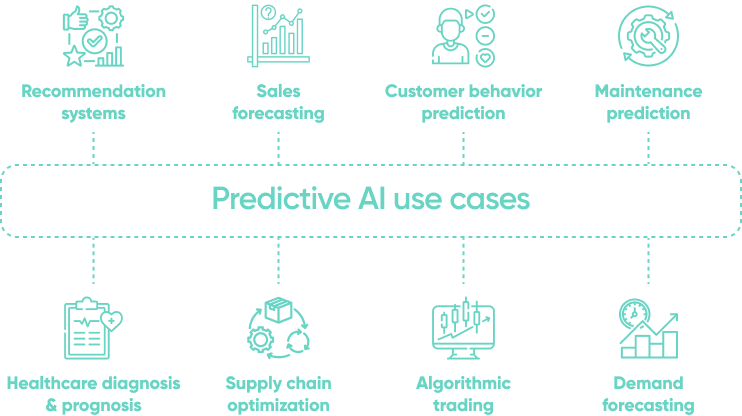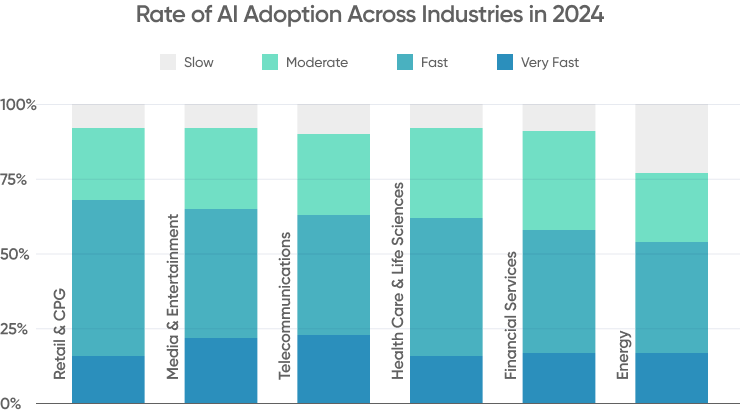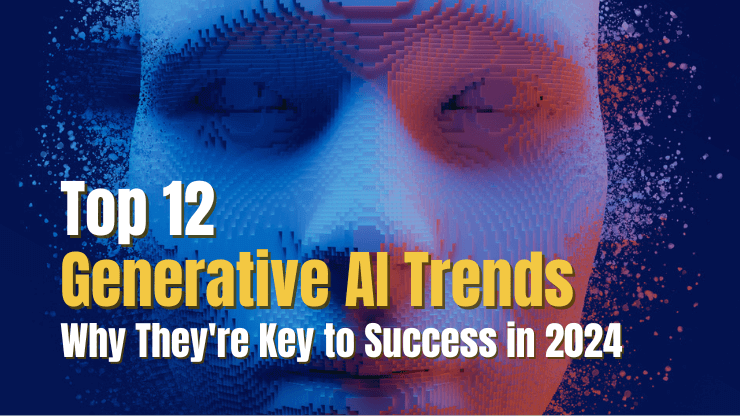AI adoption is at an all-time high. In fact, most C-suite executives describe their AI adoption rate as “fast" or "very fast" according to an MIT Technology Review survey, and their spending confirms this. By 2025, organizations are expected to dedicate over 40% of their core IT budgets to AI-driven initiatives.
The rapid integration of AI in business processes underscores the need for a clear understanding of the differences between predictive and generative AI - each offering unique benefits and applications. For business leaders seeking to leverage AI, grasping this distinction is vital in choosing a solution that aligns with their strategic goals. In this article, we’ll provide a concise overview of generative AI and predictive AI, aiming to guide you in selecting the right AI technology to drive your business forward.
What is generative AI?
Generative AI is a branch of artificial intelligence that specializes in creating new content, such as text, images, and music. This technology learns from extensive datasets, absorbing existing data patterns, styles, and information to generate novel outputs that are original yet mimic the training data.

The process typically starts with a random input vector, which is fed into a generator model. To evaluate the authenticity of the generated content, a discriminator model is used, which determines whether the output is indistinguishable from actual data. Over time, through iterative processes, these systems refine their ability to produce outputs that are increasingly realistic and plausible, continuously improving the quality and authenticity of the results.
What is predictive AI?
Predictive AI is a branch of artificial intelligence that focuses on forecasting future events or behaviors by analyzing historical data. It combines data, statistical algorithms, and machine learning techniques to create models that can effectively predict future outcomes.

The process begins with the collection and cleaning of data, followed by the identification of patterns within this data. These patterns are then used to build models that can make informed predictions about future trends or behaviors.
Generative AI vs predictive AI: 7 key distinctions
It’s evident that generative AI and predictive AI have distinct characteristics and applications. To truly appreciate the nuances and business potential of these technologies, it is essential to understand the 7 key distinctions that set them apart:
Objectives
The first significant distinction between generative AI and predictive AI lies in their core objectives and what they aim to achieve.
Generative AI is designed with the primary goal of creating new, original content or data. It excels in tasks that require innovation and the generation of novel ideas, content or products, ranging from art and music to new product designs and unique data sets. Its objective is not just to replicate existing patterns but to expand upon them, producing outputs that are both fresh and relevant.
In contrast, predictive AI focuses on forecasting and extrapolating future events or trends based on historical data. Its main purpose is to analyze past and present data to predict future outcomes, making it invaluable for decision-making in fields like finance, marketing, and healthcare.
| Generative AI | Predictive AI |
|---|---|
| Generate novel outputs: Be it text, images, or sounds, the goal is to produce new creations that didn't exist before. | Forecast accuracy: It aims to predict outcomes with a high level of precision based on historical and current data. |
| Enhance creativity: Support human endeavors by offering unique solutions, designs, or alternatives through its generative capabilities. | Inform decision-making: These models provide you with data-driven insights to make informed decisions across various sectors like finance, healthcare, and logistics. |
Technological
In exploring generative AI and predictive AI, it's crucial to examine the specific technologies that serve as their backbone. By understanding these technologies, you can better grasp how each AI type operates and the capabilities they offer.
Underlying technologies of generative AI
Generative AI is characterized by its ability to produce new content across various formats, including text, images, and data. Key to its success in natural language processing (NLP) is the use of embeddings, which transform words and phrases into dense vector representations, capturing their semantic meanings and relationships. It employs a mix of unsupervised and semi-supervised learning techniques for new data generation and relies heavily on advanced machine learning frameworks such as:
- Variational autoencoders (VAEs): VAEs compress input data into a latent space using an Encoder and then reconstruct it using a Decoder. They are adept at understanding data distribution, allowing them to generate new, similar data points by sampling from this learned distribution.
- Generative adversarial networks (GANs): GANs consist of two competing neural networks: a Generator that creates data and a Discriminator that distinguishes between real and generated data. Through their adversarial training, the Generator learns to produce increasingly realistic outputs, blurring the line between artificial and authentic data.
- Transformer: Transformers, including the GPT series, use self-attention mechanisms to effectively process sequential data like text. Trained on large datasets to predict the next sequence item, they excel in generating coherent and contextually relevant text, useful in various language-based applications.
Underlying technologies of predictive AI
On the other hand, predictive AI primarily uses supervised learning, relying on labeled data for accurate predictions. It varies in complexity; some models are simple, while others like deep neural networks are more resource-intensive. The underlying technologies are:
- Regression models that predict continuous values (e.g., prices, temperatures) by mapping the relationship between input variables and a continuous output.
- Classification models that sort data into predefined categories. They use algorithms such as Logistic Regression, Decision Trees, SVMs, and Neural Networks to assign input data to specific classes.
- Neural Networks, which are layers of neurons that learn to predict outcomes. They adapt through training, adjusting internal parameters to minimize prediction errors. Variants include simple feedforward networks and more complex forms like CNNs and RNNs.
- Ensemble methods, like Random Forest, which combine multiple models to enhance prediction accuracy. They use aggregation techniques like averaging or voting across models for more reliable outcomes.
Data handling differences
Generative AI is focused on creating new content or data points. For instance, this type of AI might generate novel images, texts, or sounds that didn't exist before based on patterns it has learned during training. It transforms input data into new forms.
Predictive AI, in contrast, is about understanding and predicting outcomes based on existing data. It reviews historical data to make assertions or forecasts about future events without creating new data points.
Because of these differences, the training data requirements are different for generative AI vs predictive AI.
| Generative AI | Predictive AI |
|---|---|
| Requires large amounts of diverse data to learn how to generate realistic outputs. | Necessitates reliable, clean historical data to identify patterns and predict future trends. |
| The quality of generated data directly depends on the variety and breadth of training data. | The emphasis is on the relevancy and accuracy of data to enhance prediction quality. |
Use cases and applications
Generative AI and predictive AI each bring a set of strengths that inform the most appropriate use cases and business applications. Let’s take a closer look at how these break down.
Generative AI use cases
There are new use cases emerging by the day, but generally speaking, with generative AI, the use cases are all about generating new content, whether its text, images, or video. A few examples of generative AI applications include:

- Drug discovery: Generative AI predicts molecular interactions to identify new drug candidates, reducing the need for physical trials.
- Realistic voice overs: It generates accurate human-like voices for advertising, entertainment, and assistive tech, eliminating the need for voice actors.
- Content creation: AI is used to create articles, stories, poetry, marketing content, website copy and more.
- Image and video generation: AI models produce or modify images and videos for creative industries based on textual descriptions.
- Chatbots: AI chatbots deliver human-like responses for customer support and complex interactions, enhancing customer service and efficiency.
- Product design: Generative AI systems facilitate the creation and iteration of product designs, streamlining the design process and innovation.
- Code generation: AI suggests code snippets and functions to speed up software development based on existing code context.
- Simulation and modeling: AI simulates scenarios in climate, economics, and urban planning for research and policy-making insights.
Predictive AI use cases
Predictive AI use cases look a little different. These are all about predicting outcomes to drive greater efficiency, anticipate failure, and make better decisions. For example, predictive AI is being used for:

- Recommendation systems: Predictive AI curates personalized content, product, and service recommendations by analyzing user behavior and preferences, enhancing user engagement and satisfaction.
- Sales forecasting: Predictive AI uses historical data to anticipate sales trends, aiding in stock and resource management.
- Customer behavior analysis: It predicts customer preferences and churn, improving CRM strategies through data analysis.
- Maintenance prediction: AI analyzes equipment data to predict breakdowns, facilitating preemptive repairs and minimizing downtime.
- Healthcare diagnosis and prognosis: Predictive AI leverages medical records to forecast diseases and patient outcomes, bettering treatment and care.
- Supply chain optimization: It improves supply chain operations efficiency by evaluating market trends, logistics, and supply data for strategic planning.
- Algorithmic trading: Predictive AI can analyze data to make automated trading decisions, aiming to maximize returns and minimize risks.
- Demand forecasting: Predictive AI analyzes historical sales data and market trends to forecast future product or service demand.
Impact on industries
It’s clear that both generative AI and predictive AI have a wide range of use cases, and businesses across industries are actively transitioning from a phase of experimentation to practical deployment in order to achieve gains in productivity, efficiency, and innovation. In fact, 60% of enterprise C-suite executives describe their organization’s rate of AI adoption as "fast" or "very fast" according to an MIT Technology Review survey.

Top industries using generative AI
Generative AI is reshaping how content is created across diverse sectors. Its ability to generate new, style-consistent content, from intricate images to dynamic video footage, is not just an innovative leap but also a cost-effective solution for many industries including:
- Retail & CPG: Companies can integrate customer support platforms like ZohoDesk with OpenAI for an AI-powered chatbot experience.
- Media and entertainment: Companies developing video games and VR/AR immersive experiences are using tools like Scenario to create AI-generated, style-consistent game assets.
- Telecommunications: Teams can generate code with tools like OpenAI Codex and GitHub Copilot.
- Communications & media: Teams can generate images, graphics, designs, and more using tools like the Canva GPT, which is part of the new GPT store.
- Real estate: Agents and brokerages can use generative AI tools like Virtual Staging AI to create virtually staged images with one click.
- Architecture & engineering: Firms can simplify the architectural design and modeling process with familiar platforms like Autodesk’s Design and Make, which now incorporates generative AI.
Top industries using predictive AI
Predictive AI is a cornerstone in the realm of data analytics and forecasting, offering unprecedented precision and insight. In industries where data-driven decisions are critical, this technology is invaluable, optimizing operations and enhancing strategic planning. Here's an overview of key sectors where predictive AI models are playing a transformative role:
- Retail & CPG: Brick and mortar retail companies can forecast sales and optimize retail markets to make the right location decisions at the right time with tools like Tango Analytics.
- Healthcare & life sciences: Companies can use Viz.ai’s advanced, FDA-cleared algorithms to analyze medical imaging data, access real-time insights, and accelerate diagnosis and treatment.
- Financial services: Institutions can leverage tools like Ocrolus to access predictive analytics and fraud detection, so they can make more informed lending decisions and onboard customers quickly.
- Energy: Teams can use C3.ai to unify data access and apply machine learning to predict asset failures in advance
- Logistics: Teams can improve their demand forecasting and optimize delivery routes with data analytics platforms like Dataiku that can be optimized for industry-specific predictive AI applications.
- Real estate: Agents and brokerages can make use of tools like Catalyze AI to help predict the most lucrative leads.
Trends in enterprise solutions
Advancements in AI have significantly transformed enterprise machine learning platforms and software solutions in recent years, and enterprises are optimistically embracing this technology to harness new levels of efficiency and innovation. Let’s take a closer look at some of the key enterprise AI trends:
Generative AI enterprise trends
- Emergence of MLLMs: The rise of multi-modal large language models (MLLMs) is revolutionizing enterprise systems, especially in customer service. These advanced AI chatbots integrate text, image, and document processing, with over 60% of organizations adopting AI for enhanced customer experiences.
- More trustworthy AI systems built on company data: AI systems are becoming more reliable by using techniques like retrieval augmented generation (RAG). RAG combines model-generated responses with external data sources, increasing accuracy and credibility while reducing misinformation.
- Document processing innovations: New LLMs like JPMorgan's DocLLM mark significant progress in processing form-based documents and PDFs. This paves the way for more efficient data interaction in enterprises and encourages the development of specialized models for intelligent document handling.
Predictive AI enterprise trends
- Predictive and proactive AI chatbots: Leveraging data analytics and pattern recognition, AI customer service bots such as Forethought.AI are equipped to anticipate customer needs and problems, providing timely suggestions and advice.
- AI-powered data analytics platforms: Enterprise-grade data analytics platforms like DOMO are getting more powerful with predictive AI-driven analytics built right in.
- Emergence of predictive sales tools: AI tools are revolutionizing sales strategies. For example, Seismic combines predictive data with human intelligence to guide enterprise sales teams, improving engagement and deal closure rates.
12 Enterprise AI Trends Dominating the Market in 2024
Top 12 Generative AI Trends & Why They're Key to Success in 2024
Risks and challenges
The incorporation of AI in various sectors comes with its unique set of risks and challenges. When it comes to generative AI, your awareness of ethical risks is crucial. Because generative AI creates realistic images, text, or audio it can lead to misuse, such as the fabrication of fake media (deepfakes), which can have serious consequences for privacy, security, and trust in media.
On the other hand, predictive AI often deals with challenges related to the accuracy and fairness of predictions. Predictive models are only as good as the data they are trained on. If the data reflects historical biases, your predictions will likely perpetuate these biases.
Let’s take a closer look at the risks and challenges of these two subsets of AI:
| Generative AI | Predictive AI | |
|---|---|---|
| Model transparency | These models often operate as "black boxes," making it difficult to understand how they generate specific outputs. | Predictive models like deep neural networks are not transparent, making it hard to understand their decision-making process. |
| Bias in data and output | Because it's trained on vast datasets from the internet, it can inadvertently learn and reproduce societal biases. | If the training data is biased or unrepresentative, the model's predictions will likely be biased too. |
| Misuse potential | Can create realistic content, including deepfakes, fake news, or plagiarism, which can be used for malicious purposes. | Can be used unethically, such as for invasive surveillance, discriminatory profiling, or manipulating consumer behavior. |
| Regulatory and ethical concerns | The ability to generate any content poses ethical dilemmas and regulatory challenges, such as ensuring compliance with privacy laws. | N/A |
| Data security risks | Exposure of business data is possible when training generative AI models. | When large data sets are collected, there is a risk of data exposure. |
| Model drift over time | N/A | Can become less accurate as data and contexts change. |
Conclusion
Generative AI and predictive AI each have their own unique capabilities and applications. Understanding these differences is key to selecting the right AI solution for your needs. Whether fostering creativity with generative AI or enhancing decision-making with predictive AI, both fields are evolving, offering innovative ways to enhance business operations.
If you're looking to develop a custom AI solution, consider our AI software development services. Our team will partner with you to build a comprehensive AI strategy, we'll assist you in selecting the most suitable AI technologies, seamlessly integrating them into your existing tech stack, and delivering a user-ready AI product. Reach out for a free quote!







